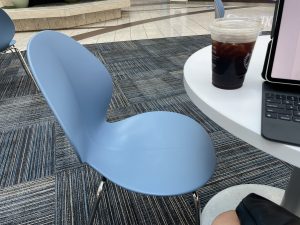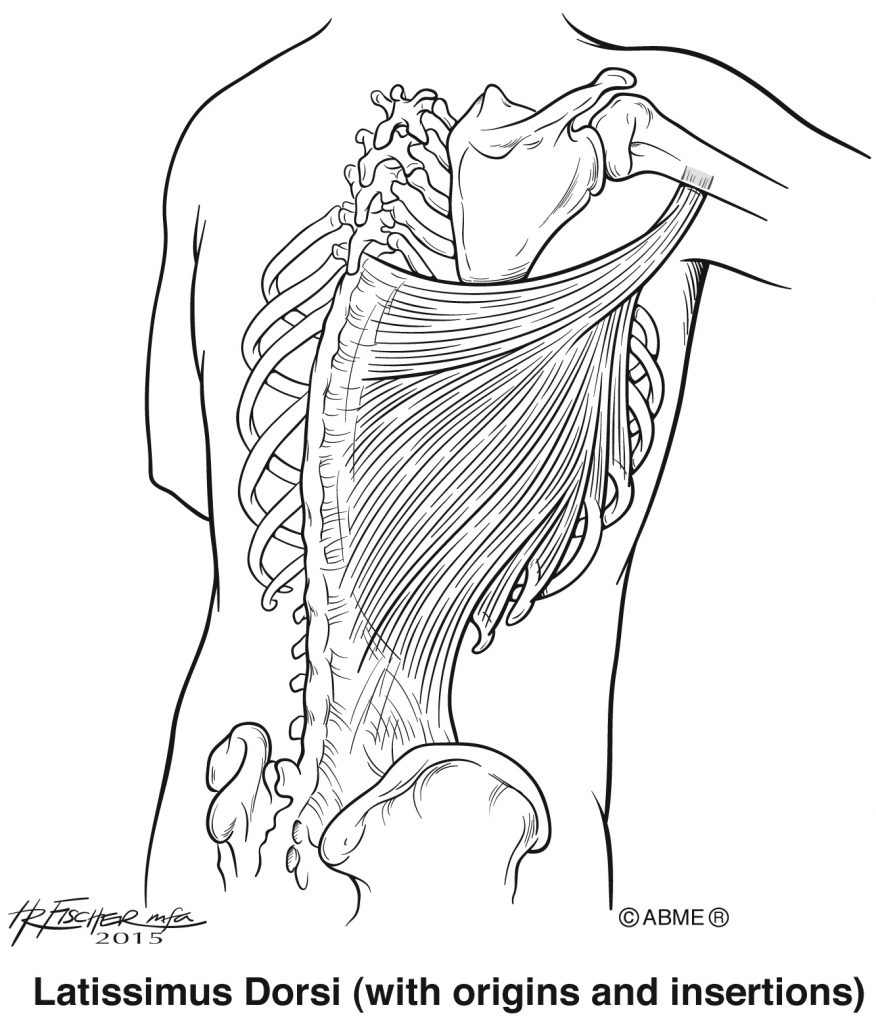In last month’s article Sitting 101, I wrote about how the chair itself is often part of the problem. In this article, I’d like to go into more detail about how to adapt the chair to fit your body, instead of the other way around, which is contorting yourself to fit the current chair. As I type this, I’m sitting in the central courtyard of our local mall, waiting for my daughter and her friend to finalize their Homecoming dress purchases, and am already noticing that while these chairs look nice, they are making my body hurt.
Last weekend, I taught two days of flute lessons as a substitute studio professor and worked on these concepts with most of the students. They were amazed at the difference simply changing the chair makes in their sound and ease of breathing.
The problem
Most chairs are slanted towards the back, with the front edge of the bottom of the chair being higher than the back. In addition, most have a scooped out area. Think bucket seat. This is indeed the shape of infant car seats, the baby is cradled in a C -shape curve that supports the baby body that they have and mimics the position the baby was in for the previous 9 months. We have evolved from babyhood and now have spines that have flexion (sacrum and thoracic spine) and extension (lumbar and cervical spines). The bottom of most seats is curved instead of flat. When we sit on this type of chair, we tend to end up in posterior pelvic tilt. This means that our rocker bones aren’t going straight down, we have rocked back off of them. Our pelvis is tucked under.
So what?
When your pelvis is constantly stuck in posterior tilt, you may notice that you’re working harder to breathe. You may feel the movements of breathing only in the front, instead of all the around. There are many moving parts within our breathing system and when any part is prevented from moving in the right direction at the right time, there’s going to be compensation of some type. Generally, we’re not so limited that our lives are in danger, but we can’t easily get the air necessary for our long phrases. Most of our abdominal muscles connect our ribs and sternum to various places on our pelvis. When bony structures are connected by muscles and/or connective tissue, how they (the bony bits) are relating to each other matters. Constant posterior pelvic tilt is impacting rib movement because the ribs and pelvis are connected by abdominal musculature.
You may find that it’s more difficult to play technical passages when stuck in posterior pelvic tilt. Our upper arm (humerus) is also connected to our pelvis through the latissimus dorsi. Constant posterior tilt is impacting arm movement because the pelvis and the upper arm bone are connected!
Possible solutions
I’ve made a video (https://youtu.be/JteE0c3SoBg) that shows the following options, but it’s probably best to read first and then watch.
Bottom of the seat
- The first thing to do is to somehow erase the scooped out area in the chair. Option 1 is a wash cloth or hand towel, which can be folded up into a bunch of shapes to even out the bottom of the chair. This is the smallest option and it can easily be folded up and shoved into the giant flute bag of stuff. (As an aside, do you really need all of that stuff everyday? Can you minimize the weight of the flute bag at all?) In my car, I have a wash cloth and a hand towel folded up to even out the seat. This is really annoying when another family member drives my car because they toss the towel pile into the back seat and then I have to refold. But, it’s worth it.
- My favorite option is a thing called a cello seat cushion, which is a wedge shaped cushion which comes in different heights. I flop this onto the chair and it immediately takes care of the hollowed out bottom of the chair problem. Many people find that they like having their hip joints slightly higher than their knees. The downside to the cello cushion is that it’s another thing to carry, as it doesn’t fit into the flute bag. However, I always take it if I’m performing someplace new and don’t know what kind of chairs will be available.
- A third option is a foam pad, a bigger version of the thing that gardeners often have to kneel on. This one came from Amazon and is black. It does the job of evening out the bottom of the seat, but again, it doesn’t fold up.
- Cushion on my piano bench. It’s ok, it does fold. Some people really like it.
- An easily transportable option is an inflatable seat cushion. I have several of these and use them on the bottom of the chair and also between my back and the back of the chair. More about that below.
- A fun option is to sit on a yoga block. You should feel your rocker bones perched on the yoga block. It’s not great for performance, but it’s a nice option for variation during practice.
Height of the chair
Short people – you have to get your feet on the floor. Scoot forward until you can reach. If you’re really having a hard time, a flute case works in a pinch to bring the floor up to you. You can also use yoga blocks, if you haven two.
Tall people – if you find that your knees are way higher than your hip joints when you sit, then the chair is too short for you. One option is to stack two or more chair together. Another option is to have chair risers, like risers for bunkbeds in dorms.
Back of the chair
Here’s a question I get from my students all the time: am I allowed to use the back of the chair? Yes, provided you can still reach the floor with your feet. I’m too short to be able to do this. Can I rest back against the back of the chair during rests or rehearsal breaks? Absolutely.
Seat backs in office chairs, car and airplane seats
Obviously, you’ll be sitting there for a while and definitely want to use the back of the chair. Often, these are curved also, forcing us back into kidney bean position. If the chair has a lumbar support, it’s often in the wrong part of the chair. It should fill in the lumbar curve in your low back. In my car, the lumbar support is too high up. The solution is to make the seat as vertical as possible and then use a cushion to fill up the available space. I really like these inflatable cushions from LL Bean. They are portable as they can be squished down. These travel really well unless you get off the airplane and leave it in your seat.
Another option
Standing is another option we have. Many years ago, I transitioned to a standing work desk at my home, which completely eliminated the chair problem. I also have a Swopper stool (https://www.amazon.com/aeris-Swopper-Ergonomic-Stool-17-7-23-2seat/dp/B086LCVZQ3/ref=asc_df_B086LCVZQ3/?tag=hyprod-20&linkCode=df0&hvadid=533403187665&hvpos=&hvnetw=g&hvrand=4691480289673464732&hvpone=&hvptwo=&hvqmt=&hvdev=c&hvdvcmdl=&hvlocint=&hvlocphy=9015284&hvtargid=pla-928976479584&psc=1)(Swopper) for long Zoom meetings when I feel that I want to sit for part of the time. It encourages movement.
We cannot sit like sitting is in the stillness category. If we do, then we’re doing a lot of muscular work to stabilize ourselves and hold still, which makes it even harder for those muscles to be doing their thing for music making. It’s much easier to execute the techniques I wrote about in Sitting 101 when the chair is set up to fit your body better. Give it a try and find out what works for you!
Links to the stuff….
Cello Chair Cushion (https://www.celloseatcushions.com/)
Black foam kneeling pad (https://www.amazon.com/CLB-Kneeling-Comfortable-Waterproof-Seat19-5×14-5×1/dp/B08B52MRT6/ref=sr_1_6?crid=2252J986F1744&keywords=black+foam+kneeler&qid=1662998066&sprefix=black+foam+kneeler%2Caps%2C108&sr=8-6)



